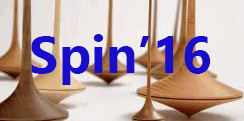Speaker
Description
There exist new polarized structure functions b1−4 for spin-one hadrons such as the deuteron. These functions probe very different nature of hadron spin physics from the longitudinally polarized distributions measured by g1 for the nucleon. The twist-two structure functions b1 and b2 are expressed by tensor polarized parton distribution functions, which indicate unpolarized parton distributions in the tensor-polarized spin-one hadron [1, 2]. In this work, we investigate the function b1 in the standard convolution model for describing the deuteron. There are such initial studies in Ref. [1]. The purposes of this work [3] are to test their numerical result and then to compare our function b1 with the HERMES measurement [4]. In particular, there is an interesting indication that the magnitude of the HERMES data is much larger than the standard deuteron model predication. Before stepping into possible exotic mechanisms, such as hidden color [5], to interpret the HERMES b1, we need to confirm that the data really cannot be explained by the standard model for the deuteron. Using a convolution integral for calculating nuclear structure functions, we obtain the structure function b1 which is expressed by the lightcone momentum distribution for the nucleon in the deuteron and the unpolarized structure function F1 for the nucleon [3]. Then, the lightcone momentum distribution is calculated by using a momentum space wave function for the deuteron with D-state admixture. The structure function F1 is calculated by the unpolarized parton distribution functions with a typical parametrization for the longitudinal-transverse ratio R. We found that the function b1 calculated in this standard description is very different from the HERMES measurement [3]. It suggests that new hadron physics should be needed for explaining the HERMES measurement. Since there is an approved experiment at JLab [6] to measure b1 and polarized proton-deuteron Drell-Yan process could be possible at Fermilab [7], it is an interesting hadron-physics topic with the possibility of creating a new field in high-energy spin physics.
References
[1] P. Hoodbhoy, R. L. Jaffe and A. Manohar, Nucl. Phys. B 312, 571 (1989); H. Khan and P. Hoodbhoy, Phys. Rev. C 44, 1219 (1991).
[2] S. Kumano, J. Phys. Conf. Ser. 543, 012001 (2014).
[3] W. Cosyn et al., KEK-TH-1912/J-PARC-TH-0054, to be submitted for publication.
[4] A. Airapetian et al. (HERMES Collaboration), Phys. Rev. Lett. 95, 242001 (2005); S. Kumano, Phys. Rev. D 82, 017501 (2010).
[5] G. A. Miller, Phys. Rev. D 89, 045203 (2014).
[6] Proposal to Jefferson Lab PAC-38, J.-P. Chen et al. (2011).
[7] S. Kumano and Qin-Tao Song, arXiv:1606.03149 [hep-ph].
